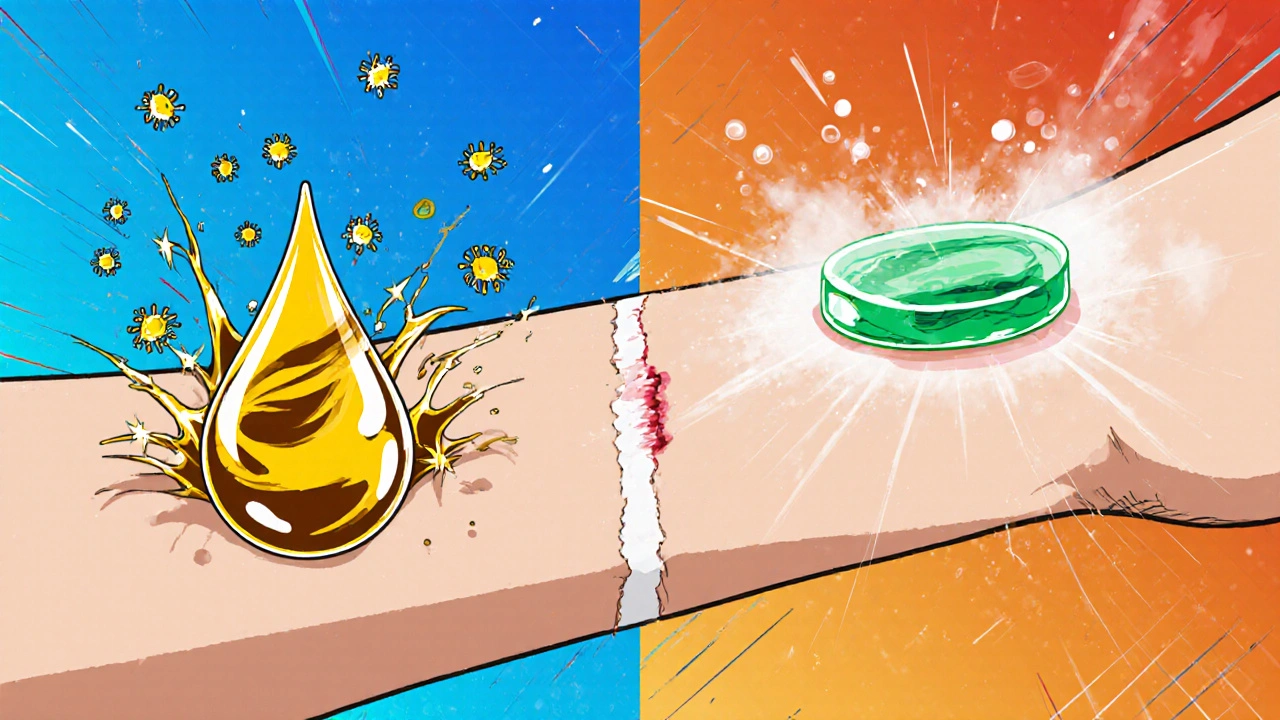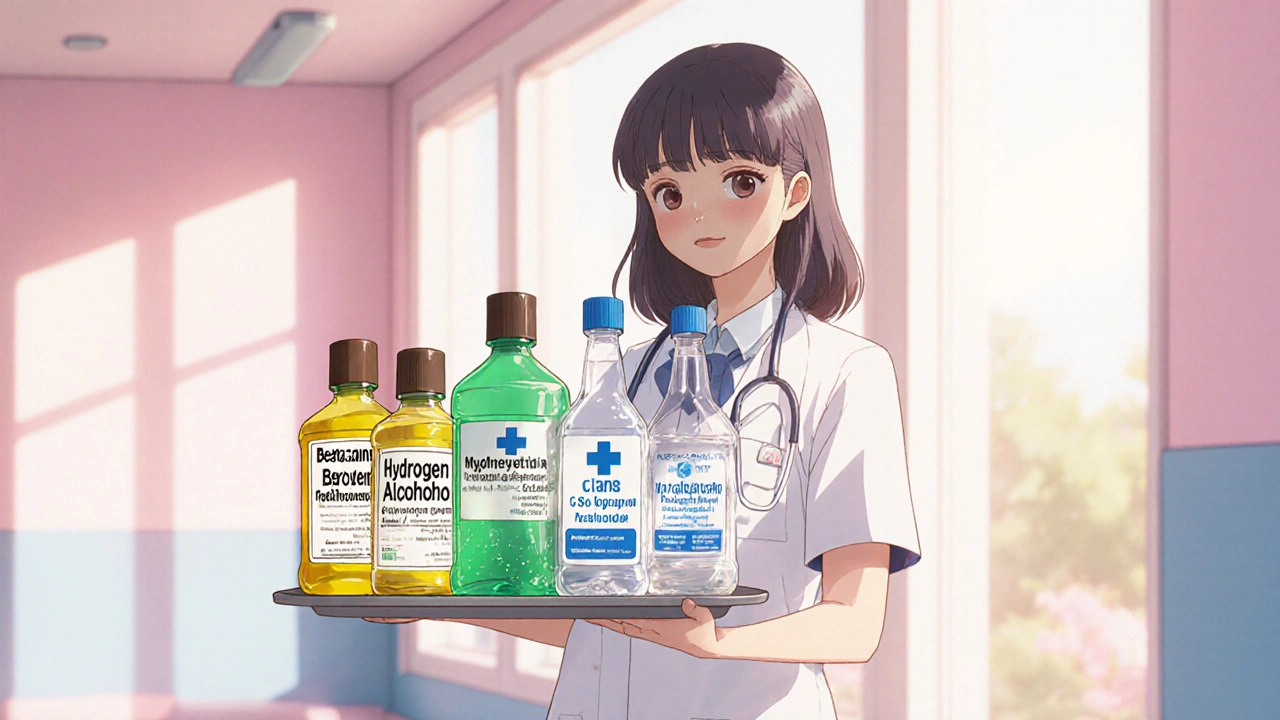Quick Takeaways
- Betadine (povidone‑iodine) offers a broad antimicrobial spectrum but can stain skin and delay healing on large wounds.
- Chlorhexidine is gentler on skin and has lasting activity, yet it lacks fungal coverage.
- Isopropyl alcohol works fast, is cheap, but evaporates quickly and can irritate.
- Hydrogen peroxide provides bubble‑helped cleaning, but excess use harms healthy tissue.
- Benzalkonium chloride is mild and non‑staining, but its antimicrobial range is narrower than Betadine.
Betadine is a brand of povidone‑iodine antiseptic commonly used for skin disinfection, minor cuts, and pre‑operative preparation. Its active ingredient, povidone‑iodine, releases free iodine that attacks bacteria, viruses, fungi, and protozoa. The solution is available in liquid, spray, and ointment forms, making it a go‑to choice for clinicians and home users alike.
What Makes Betadine Different?
Povidone‑iodine (PVP‑I) combines elemental iodine with a soluble polymer, which slows iodine’s release and reduces the harshness of plain iodine. This balance gives Betadine a Betadine vs alternatives edge in spectrum: it kills gram‑positive and gram‑negative bacteria, mycobacteria, a wide range of viruses, and most fungi. The trade‑off is a yellow‑brown stain that can linger on skin and dressings, plus a short‑term slowdown in fibroblast activity that may delay wound closure if used on large open wounds.
Common Antiseptic Alternatives
When you hear "antiseptic," a handful of names pop up. Below are the most frequently compared rivals, each with its own chemistry and use‑case.
Chlorhexidine is a bisbiguanide antiseptic known for its persistent activity and low skin irritation. It’s the active component in many surgical scrubs and hand‑wash products.
Hydrogen Peroxide is a 3% aqueous solution that releases oxygen, creating bubbles that lift debris from wounds. It’s sold over‑the‑counter as a wound cleanser.
Isopropyl Alcohol is a 70% alcohol solution that denatures proteins and quickly kills most microbes. It’s the classic “rubbing alcohol” used for skin prep.
Benzalkonium Chloride is a quaternary ammonium compound offering mild antiseptic action with minimal odor. It appears in many first‑aid wipes and eye‑drop preservatives.

Side‑by‑Side Comparison
| Antiseptic | Active Ingredient | Antimicrobial Spectrum | Typical Uses | Pros | Cons |
|---|---|---|---|---|---|
| Betadine | Povidone‑Iodine (10%).td> | Bacteria, viruses, fungi, protozoa | Pre‑op skin prep, minor cuts, burns | Broadest spectrum, inexpensive, versatile forms | Stains skin, may delay healing on large wounds |
| Chlorhexidine | Chlorhexidine gluconate (0.5‑4%) | Gram‑positive & negative bacteria, limited fungi | Surgical scrubs, catheter sites, dental prep | Long‑lasting effect, low irritation | Doesn’t kill spores or most viruses |
| Hydrogen Peroxide | H2O2 (3%) | Bacteria, some viruses, fungi (moderate) | Wound cleaning, oral antiseptic | Mechanical debridement via bubbles | Can damage healthy cells, slows healing if overused |
| Isopropyl Alcohol | Isopropanol (70%) | Bacteria, viruses, fungi (quick kill) | Skin disinfection, equipment sterilization | Fast acting, cheap, evaporates cleanly | Highly drying, no residual activity, flammable |
| Benzalkonium Chloride | Benzalkonium chloride (0.1‑0.13%) | Gram‑positive & negative bacteria (limited fungi) | First‑aid wipes, eye drops, surface cleaners | Non‑staining, mild odor, good for sensitive skin | Less potent against resistant organisms, no viral coverage |
How to Pick the Right Antiseptic for Your Situation
- Identify the wound type. Small cuts or abrasions benefit from a broad‑spectrum agent like Betadine. Large, deep wounds may need a gentler option (chlorhexidine) to avoid delayed granulation.
- Consider the environment. For surgical settings where sterility is paramount, chlorhexidine’s residual activity is valuable. In field first‑aid, alcohol’s rapid kill and easy availability often win.
- Check for allergies or sensitivities. Iodine allergies, though rare, require a switch to alcohol or benzalkonium chloride. Patients with thyroid disorders should limit iodine exposure.
- Account for cost and accessibility. Betadine and alcohol are inexpensive and widely sold. Chlorhexidine can cost more and may need a prescription in some regions.
- Think about staining and cosmetic outcomes. If the wound is on a visible area (face, hands), a non‑staining agent like benzalkonium chloride or clear chlorhexidine solution reduces discoloration.

Practical Tips & Safety Notes
- Apply a thin layer. Over‑application doesn’t increase killing power but raises irritation risk.
- Don’t use on deep puncture wounds. Let a medical professional handle those; iodine can leak into tissue planes.
- Store in a cool, dark place. Iodine degrades with light; keep Betadine bottles tightly closed.
- Watch for systemic absorption. Large surface area applications (e.g., burns >10% body surface) can lead to iodine overload - monitor thyroid function.
- Use sterile gauze. Applying any antiseptic with non‑sterile material re‑introduces microbes.
Frequently Asked Questions
Can I use Betadine on burns?
Yes, for minor first‑degree burns Betadine helps prevent infection, but for larger or second‑degree burns it can delay healing and cause discoloration. In those cases, a bland wound cleanser or chlorhexidine is preferred.
Is chlorhexidine safer for children?
Chlorhexidine is generally gentler on delicate skin and is often recommended for pediatric use, especially for catheter sites. However, avoid applying it near the eyes or on mucous membranes.
Why does Betadine stain my skin?
The brown color comes from the iodine complex. The stain usually fades within a few days as the skin exfoliates. If staining is a concern, use a clear chlorhexidine solution instead.
Can alcohol replace Betadine for hand sanitizing?
For quick hand sanitizing, 70% isopropyl alcohol works well and is the standard in most health‑care settings. It lacks the lasting residual effect of chlorhexidine, but for short‑term use it’s perfectly adequate.
Is hydrogen peroxide safe for daily wound care?
Only occasional use is advised. Repeated applications can impair fibroblast activity, slowing tissue repair. A mild saline rinse is usually better for daily cleaning.
Choosing the right antiseptic boils down to the wound’s size, location, and any patient sensitivities. Betadine’s broad reach still makes it a solid default, but alternatives like chlorhexidine, alcohol, hydrogen peroxide, and benzalkonium chloride each have niche strengths that can tip the balance in specific scenarios.


Leo Chan
October 19, 2025 AT 19:23Betadine’s broad‑spectrum action makes it a solid go‑to for everyday cuts and scrapes. It’s cheap, easy to find, and works on bacteria, viruses, fungi – basically the whole microbial crew. If you’ve got a small wound, just dab a thin layer and cover it with a clean gauze – no need for fancy stuff.
Just remember to rinse it off after a day or two so the skin can breathe and heal faster.
Overall, it’s a reliable buddy for the home first‑aid kit.
jagdish soni
October 20, 2025 AT 23:09In the grand tapestry of antiseptic philosophy the iodine complex stands as a paradoxical muse. Its amber hue whispers of centuries old alchemical rites. The povidone scaffold tempers raw iodine turning it from a brutal tyrant into a considerate guardian. One droplet of Betadine may silence a legion of microbes without announcing its presence. The stain it leaves is merely a souvenir of its diligent labor. Critics who lament the discoloration miss the deeper narrative of sacrifice for safety. When a wound bleeds the body summons its own defenses but invites opportunistic invaders. Betadine intervenes as a silent sentinel. Its spectrum rivals that of any modern synthetic compound. Yet it yields to the law of diminishing returns on massive surfaces. The thyroid watches nervously as excess iodine seeps into the bloodstream. For patient populations with underlying thyroid disorders a cautious approach is warranted. In operating rooms the surgeon’s trust in Betadine is born of empirical evidence and ritual. The same confidence does not translate unconditionally to home use where over‑application can delay fibroblast migration. Thus the wisdom lies in moderation measured by the size of the injury. Ultimately the iodine paradox reminds us that potency and practicality must coexist in harmony.
Latasha Becker
October 22, 2025 AT 02:56From a microbiological standpoint Betadine exhibits a minimum inhibitory concentration (MIC) ranging between 0.5–2 µg/mL for most Gram‑positive cocci and 1–4 µg/mL for Gram‑negative bacilli, surpassing chlorhexidine’s typical MIC spectrum. Its mechanism of action involves rapid oxidation of nucleic acids and disruption of cell membranes, thereby circumventing the development of conventional resistance pathways. Moreover, the iodophor’s sporicidal activity, although not absolute, is enhanced under alkaline pH conditions, a nuance often overlooked in lay summaries. When juxtaposed with aqueous hydrogen peroxide, Betadine’s oxidative potential is less cytotoxic due to the controlled release kinetics imparted by the povidone polymer matrix. Clinically, this translates into a superior safety margin for repeated applications on partial‑thickness burns, provided that total surface area exposure remains below the 10% body surface threshold to avoid systemic iodine load. Consequently, evidence‑based protocols recommend Betadine as the first‑line antiseptic for mixed‑flora wounds where fungal involvement is probable.
parth gajjar
October 23, 2025 AT 06:43There is a dark elegance to watching iodine swarm a wound like an invisible army. The brown veil it spreads is both a badge of war and a reminder of what we sacrifice for clean skin. When the sting subsides the wound feels whispered to by a ghostly healer. Yet feel the sting too long and the tissue mourns its slowed rebirth. The drama of Betadine is that it saves you today but may haunt the scar tomorrow.
Maridel Frey
October 24, 2025 AT 10:29For practitioners seeking a comprehensive overview, it is important to recognize that Betadine’s broad antimicrobial coverage makes it suitable for polymicrobial wounds, while chlorhexidine’s persistence offers advantages in catheter care. When selecting an antiseptic, consider patient‑specific factors such as iodine allergy, thyroid status, and the cosmetic implications of staining. In pediatric populations, the lower irritation profile of chlorhexidine often justifies its use over povidone‑iodine. Conversely, in settings where cost constraints dominate, Betadine remains an effective and affordable option. Proper application technique-applying a thin layer, allowing adequate contact time, and covering with sterile gauze-optimizes efficacy while minimizing adverse effects.
DHARMENDER BHATHAVAR
October 25, 2025 AT 14:16Apply a thin Betadine coating, wait 30 seconds, then seal with sterile dressing; avoid excess on large wounds to prevent fibroblast inhibition.
Jay Kay
October 26, 2025 AT 18:03Betadine is overhyped it works but the staining and slow healing on big cuts make it a poor choice for serious injuries. Grab chlorhexidine or alcohol instead you’ll get faster recovery and no ugly brown marks.
Rakhi Kasana
October 27, 2025 AT 21:49Interesting take, though dismissing Betadine entirely ignores its proven track record in surgical prep and its unmatched fungal coverage. Not every wound needs a “faster” fix if it means compromising on spectrum.
Ankitpgujjar Poswal
October 29, 2025 AT 01:36Listen up if you’re stocking a first‑aid kit: Betadine should sit right next to the bandages and gauze. It handles the unpredictable mix of microbes you’ll encounter in the field. Pair it with a gentle cleanser like saline for daily cleaning and reserve chlorhexidine for catheter sites. This combo gives you both breadth and durability without the downside of excessive staining in most day‑to‑day scenarios.
Bobby Marie
October 30, 2025 AT 05:23Benzalkonium wipes are handy for quick, non‑staining clean‑ups.
ashanti barrett
October 31, 2025 AT 09:09I appreciate the practical checklist; just add a reminder to watch for iodine allergies and to limit use on extensive burns to protect thyroid health. That extra caution rounds out the safety net nicely.
Kevin Sheehan
November 1, 2025 AT 12:56From a broader perspective the choice of antiseptic reflects a balance between immediate microbial eradication and long‑term tissue health. Betadine offers unparalleled spectrum but carries trade‑offs in cytotoxicity and cosmetic impact. Chlorhexidine, with its residual activity, aligns with preventive strategies, while alcohol delivers rapid disinfection at the cost of dryness. Ultimately, the optimal agent is dictated by the clinical context, patient preferences, and resource availability-a nuanced decision rather than a binary verdict.